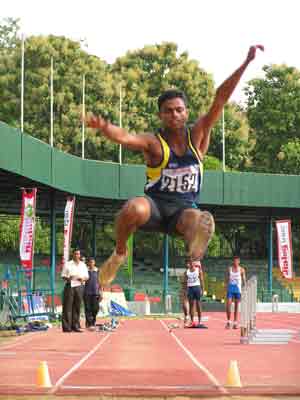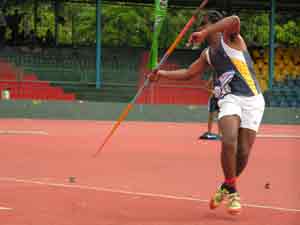
Are you ready to face the challenge?
Susanthika’s story is inspirational and can only serve to drive the nation’s youth to new levels of determination. Her upbringing was punctuated by daily hardships and poverty like many of the participants at last week’s National Youth Championships at Sugathadasa stadium. Her medal at Sydney was the first Olympic medal for Sri Lanka since 1952, a fact that clearly sits uncomfortably with Gen. Palitha Fernando, president of the Athletics Association of Sri Lanka. “Everything goes in cycles.” He says. “In the early seventies we achieved a good rate of success at Asian level but there are peaks and roughs. Again, in the eighties, there was a short spell of success but then these athletes began to retire from the sport. Without immediate up-and-coming replacements there was a generation missing from the sport”. In the mid-nineties, Sri Lankan athletes hit a run of form which has been maintained to the present. But with the average age of the current top level at 30, many are set to retire forcing a repetition of the talent drought of the eighties. With the average age of the established and regular medal-winning nations at 23 years, he has identified the London Olympics of 2012 as an achievable target. The Sri Lankan squad that travelled to Athens in 2004 numbered only 8 comprised of track specialists, swimmers and marksmen but he is hopeful that by 2012, a squad of at least a 16 will travel to London. In the past, Sri Lanka has generated some impressive results in track events and this tradition is to be carried on and encouraged. In the field, the high jump, long jump and the triple jump are to be the focus. He has also seen an opportunity that could pay off in relay events with middle-distance running being identified as a weakness. Perhaps the biggest weakness and the root of most under achievement is poverty. Developing the physique needed to stand a chance at any sport can be beyond the reach of some. Nutrition and diet are vital at all stages of physical development and a belly full of the right stuff goes a long way to securing mental well-being as well as the right attitude. On July 16, 2007, Gen. Fernando submitted the National Track and Field Standardization to the Ministry of Sport. This new criteria is the first of its kind in Sri Lanka and has been designed to give hopeful athletes a realistic aim in their chosen discipline. Each event is graded into four levels of achievement so that there are specific targets for every discipline, age group and gender. A certificate is awarded to those who reach or surpass their grading. For the ones who earn a grade one certificate, a more concentrated training programme is in place that could make the sky their limit. The plan has received the blessing and support of the Ministry of Sport and it is hoped that athletics can be further popularised by newly introduced monthly coaching clinics. Families from out-stations are invited to Colombo where the children receive senior level coaching, technique fine-tuning and advice on nutrition. Getting the most food-value from a meal through food preparation is also taught. A foster parent scheme (suggested by the previous regime), launched to provide logistical help, proved difficult to put into practice however, because of a lack of resources and the success of the first coaching clinic in April was modest. From 50 expected, only 16 attended. But the most recent clinic at the end of June showed a 90% attendance. “Developing the youth is also a priority because young people have a habit of growing up. At under 16 level, the participation is 100%. There are much fewer at under 20 and no women at under 23 level because by then they are concentrating on their studies or looking towards a career.” In a sport where so many elements have to combine, not all of them are within the control of the athlete. As well as nutrition, coaching, physiotherapy and medical support, it is a cold reality that you stand a much better chance of becoming the complete athlete if you are the right shape. Shoes can also be helpful. |
|| Front
Page | News | Editorial | Columns | Sports | Plus | Financial
Times | International | Mirror | TV
Times | Funday
Times || |
| |
Copyright
2007 Wijeya
Newspapers Ltd.Colombo. Sri Lanka. |
 Sprinter Susanthika Jayasinghe won the bronze medal in the 200 metres sprint at the Sydney Olympics in 2000. Four years later her dream of improving on bronze in Athens lay in ruins after she fractured her leg just prior to the event. As Sri Lanka’s greatest medal hope, the disappointment was felt nationwide.
Sprinter Susanthika Jayasinghe won the bronze medal in the 200 metres sprint at the Sydney Olympics in 2000. Four years later her dream of improving on bronze in Athens lay in ruins after she fractured her leg just prior to the event. As Sri Lanka’s greatest medal hope, the disappointment was felt nationwide.  During last week’s championships an excellent example of the divide in the classes presented itself during the final of the women’s U 20’s 5,000 metres. In a field of 15, only one runner enjoyed the luxury of running spikes.
The event was won by W.K.L.A. Nimali of the Lanka Lions Sports Club. She wasn’t wearing shoes. As an obvious talent, one can only wonder what giant steps could be taken if, along with the right training, she were to be given the practical advantage of a good pair of running shoes.
Not only did she win, she beat the new grade II standardized time. Remember the name.
During last week’s championships an excellent example of the divide in the classes presented itself during the final of the women’s U 20’s 5,000 metres. In a field of 15, only one runner enjoyed the luxury of running spikes.
The event was won by W.K.L.A. Nimali of the Lanka Lions Sports Club. She wasn’t wearing shoes. As an obvious talent, one can only wonder what giant steps could be taken if, along with the right training, she were to be given the practical advantage of a good pair of running shoes.
Not only did she win, she beat the new grade II standardized time. Remember the name.